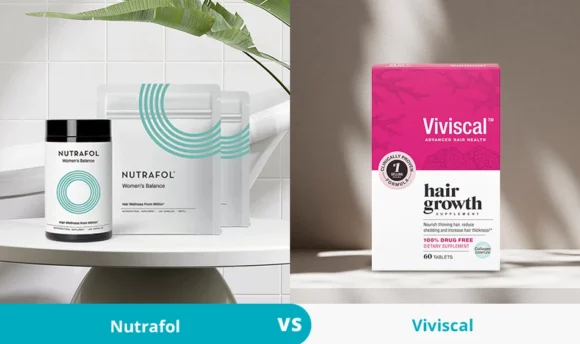Type 4c Hair (Coily): Styling Tips and How to Take Care of It
Type 4c is the curliest of all curly hair types and therefore requires extra care. Follow our guide to keeping your natural hair type in pristine condition for healthy hair and flawless coils.

Managing your hair is half the battle when you know your unique hair type. You can create daily and weekly hair habits to make the most of your natural curls, whether that means reducing the number of wash days, moisturizing regularly, or investing in curl-enhancing formulas.
If your hair is super curly, voluminous, and tightly compact, you may have type 4c hair. So how do you navigate these extraordinary curls and make the most of your natural hair?
Learn more about type 4c hair to better manage your curl pattern.
What Is Type 4c Hair?
Type 4c hair is as curly as hair comes. It is the last of the 3 coily hair types and holds the tightest curl pattern, with tight coils and dense texture. The curl patterns usually have no definition, and the hair strands tend to clump at the ends.
Even though type 4c hair is very coarse and dense, it is the most fragile of all the hair types. People with this curl type tend to experience more breakage, dryness, hair damage, and frizz.
Pros of type 4c hair
4c is a wonderful hair type with many advantages. Of course, it takes an effective haircare routine to ensure these tighter curls stay healthy and always look their best.
Here are 3 pros of type 4c hair.
- Unique curl shape: Type 4c hair has different curls from other coily hair types. The hair bends at sharp angles, creating zigzag shapes that are so tight they are sometimes impossible to see clearly. Type 4b hair also has a zigzag pattern, but it is more distinguishable to the eye at first glance.
- Full of volume: Since type 4c hair experiences a lot of shrinkage, it becomes incredibly voluminous. The tight kinks spring upwards, forming a head of hair that grows outward rather than downward. You don’t need to apply volumizing products; just enjoy your hair’s natural lift.
- Versatile for styling: It’s easy to create new looks with type 4c hair. You can style it in various ways, and it will remain in place for long periods without much manipulation or heat damage. Ultimately, you can get as creative as you like with different hairdos and accessories.
Cons of type 4c hair
As many people in the curly community know, there is a downside to having type 4c hair. As the kinkiest, coarsest, and driest hair type, it is susceptible to a few problems.
- It’s very delicate: Type 4c hair is extremely fragile. The hair strands get incredibly dry and can break and snap easily, even from simple procedures like combing and detangling. It’s because the natural oils cannot reach and protect the strands from root to tip. It’s vital to care for your natural hair.
- Frizz-prone: Frizz is the result of dehydrated hair. Because there is a lack of moisture, your hair strands search for moisture in the air and soak it up, resulting in frizzy, hard-to-control locks. This is one of the biggest problems that can be addressed with proper haircare for this hair type.
- It tangles easily: Unlike the loose curls of type 4a hair, type 4c curls are packed tightly together. The cuticle layers can overlap each other, and this causes the hair to tangle, matt, and form knots. Tangling also occurs when the strands are too dry because the cuticles do not lie flat.
How to Take Care of Type 4c Hair: 7 Proven Strategies
All hair types have pros and cons, but you can strike a balance when implementing the right haircare regimen. Below are some of the best practices for type 4c hair texture.
#1 Shampoo less often than you’d want
Washing your hair feels great, but it’s vital that you keep your wash days to a minimum. Type 4c hair is already extremely dry, and over-shampooing strips the essential oils that the sebaceous glands in your scalp secrete. You need these oils to naturally lubricate your hair.
Washing your hair and scalp a couple of times a month with a gentle cleansing shampoo is usually sufficient for 4c hair types. It sounds like a long time, but you can co-wash between wash days. Co-washing, or conditioner washing, is when you cleanse the hair with conditioner only.
It’s beneficial for dry and textured hair types because it cleans the scalp without removing moisture.
#2 Deep condition generously
Using a deep conditioner restores moisture and helps to repair and prevent breakage. You can deep condition once a week if your hair is dehydrated, leaving the treatment on for 20–30 minutes. Apply a generous amount to coat every hair strand for shinier and softer tresses.
#3 Use the LOC method
The LOC method is perfect for coily hair types because it promotes ultra hydration. LOC stands for leave-in conditioner, oil, and cream. Following these 3 steps in the same order every time you cleanse your hair will seal in moisture and prevent frizz.
#4 Get rid of split ends
The only way to get rid of split ends is with regular trimming. Type 4c hair is more susceptible to dry ends, and it’s crucial that you remove these ends before they extend up the hair shaft and cause the hair to snap off.
Regular trips to the salon will keep your hair in healthy condition and support the hair growth process. A haircut every 6–8 weeks is acceptable for most people, but you can monitor your split ends and schedule trims when necessary.
#5 Detangle regularly
Your tight corkscrews tangle easily, but you can prevent this with a proper detangling routine. It’s best to detangle your hair while it’s soaking wet or coated in conditioner. You can use your fingers to gently comb through the length to minimize tool breakage.
A leave-in conditioner can also help you detangle while wet.
#6 Go for simple hairstyles
The simpler the style, the less damage it is likely to cause. Stay away from heat tools, tight hairstyles, and rubber bands that put extra stress on your hair. Instead, use popular protective styles that minimize damage and hair ties made of soft, non-friction materials.
#7 Protect your hair at night
You still need to protect your curly hair when the day is over. You can do this by wrapping your hair in a silk scarf, using protective styles like the pineapple at bedtime (piling your curls on top of your head and tying them with a scrunchie), or investing in a satin pillowcase.
What Hairstyles Are Ideal for Type 4c Hair?
You can experiment with different styles if you have this type of coily hair. Shorter styles work well because they show off your thick texture in a stylish way. Alternatively, you can grow your hair longer if you want it to fall down instead of growing horizontally.
Some of the best type 4c hairstyles are:
- Bob cut: A curly bob creates bounciness and a flattering shape.
- Layered cut: Layers are good for highlighting your natural curl pattern.
- Pixie cut: The pixie is a very low-maintenance style to manage your coils.
- Shoulder-length cut: A shoulder-length cut helps your curls to frame your face.
Style-wise, you can play around with different looks. Some fun examples include:
- Box braids: These are good for adding length.
- Bantu knots: This protective style helps stretch out your curls.
- Slick-back bun: A quick and simple way to handle your curls for a sleek look.
- Space buns: Space buns are a playful and trendy look that highlights your features.
- Twist outs: This style protects the hair from moisture loss and boosts curl definition.
How to define 4c curls
You can add curl definition to your tight coils by prioritizing moisture. Moisturization should begin on wash day when you cleanse and condition with a nourishing shampoo and conditioner. You can then dry the hair as gently as possible using a microfiber towel.
You can hydrate your hair further by applying styling products to wet hair and generously coating the hair strands. These are the very first steps to define your tight curl pattern and minimize frizz before the hair dries. Remember never to brush your tight curls when dry, as this will immediately disrupt your curl patterns and result in overly frizzy hair.
Best Hair Products for Type 4c Hair
The natural texture of type 4c hair can thrive with a haircare plan featuring the best hair products. Always keep hydration in mind when shopping for hair products, as this is the most important thing for dry hair types like 4c that struggle to distribute the scalp’s natural oils.
The following ingredients will help bring out your hair’s natural beauty:
- Avocado and avocado oil
- Aloe vera
- Coconut oil
- Honey
- Jojoba oil
- Olive oil
- Shea butter
You can find these ingredients in most haircare items, from shampoos to leave-in conditioners. The Moérie Mineral Shampoo is perfect for supporting dry and damaged hair. It can also boost hair growth, which is ideal for the fragile 4c hair type that tends to snap easily.
FAQs
Washing your hair and letting it dry naturally will help you determine your hair type. Type 4c hair is the last of the curly hair types and is recognizable by its densely packed, tight Z-shaped coils. The texture is coarser than others in the hair type system.
Most people with the 4c hair type can benefit from applying oil to the hair strands every 2–3 days. Regularly oiling your hair lubricates the hair shaft and prevents the swelling and drying of the strands. Avocado, castor, and coconut oil are ideal for hydration and hair growth.
Type 4c hair barely retains moisture, so adding moisture regularly with haircare products is vital. Moisturize every time you wash your hair (once or twice a week) and apply a leave-in conditioner. You can also deep condition weekly and apply hair oils every other day.
Type 4c hair is the most fragile of all 4 hair types in the hair typing system. The tightly coiled tresses are more vulnerable to dryness, breakage, frizz, and hair shedding than other types. Protecting this particular hair texture is essential for maintaining healthy and attractive curls.
A Word From a Trichologist
The hair typing system comprises different hair types, including straight hair, natural waves, curly hair, and coily hair. Type 4c hair is the final hair category and boasts the curliest hair shaft. It requires a little more maintenance than other types, but it’s easy to control with the correct methods.
Moisturizing ingredients, deep conditioning, regular trims, and a sleep routine are some key tricks to keeping healthy hair.
You can also nourish your strands from the inside by drinking plenty of water, eating a balanced diet, and consuming the right nutrients to prevent hair loss.
Conclusion
If you have type 4c hair, you have the curliest, kinkiest, and most delicate hair type. And with that comes the need for more tender loving care. These tight curls don’t have to be unmanageable. You can easily take control with simple care and a routine.
The best routine includes plenty of moisture, natural ingredients, and regular trimming with minimal washing, heat styling, and brushing.

















































 Select your language:
Select your language: 








